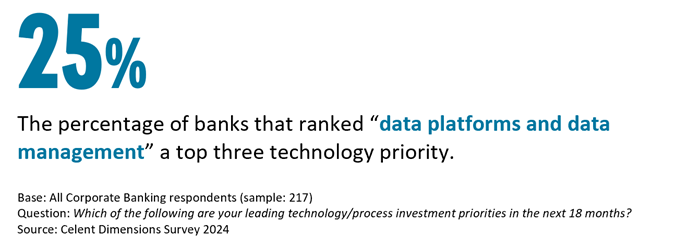AI Ambition is Fueling Investment in Data Platforms
Celent recently published the Dimensions: IT Pressures and Priorities report series. This annual survey of bank executives worldwide is used to identify the technology trends and spending priorities of financial institutions in each market segment. Over 200 banks responded to the corporate banking survey.
The Celent Dimensions survey asked banks about their top-ranked technology priorities. For corporate banking, data platforms and data management topped the list (followed very closely by cybersecurity).

What a difference a year makes! In 2023 data and cybersecurity were low-ranked priorities, with data platforms not even making the top 10 technology priorities. However, this shift from 2023 to 2024 didn’t surprise me at all. Over the course of the past year, I have talked with numerous banks about their data and AI strategy. What became clear in those discussions was that many banks have uncovered a capability gap. Data may be the fuel for AI, but the promise (and hype) of AI in all its forms has exposed weaknesses in the ability of the data platforms at many banks to support growth in AI.
As an industry banking is moving beyond data science projects and focused AI applications toward intelligent solutions and business workflows. Until now, AI use cases tended to be developed ad hoc by different parts of the technology organization or embedded in vendors’ applications. To move to the next level, banks must scale AI across the enterprise. To achieve AI success, banks have a critical dependency on the quantity, quality, consistency, and availability of data necessary to reliably develop AI models and solutions. Banks are increasingly turning to hyperscaler technology stacks to address their data challenges and to consume the fast moving AI tools and services.
As an example of a bank "doing data well" – this year Celent awarded Singapore’s DBS Bank a Celent Model Bank Award for ”Industrializing AI.” This is the result of a five year journey. It began with an executive vision that pitched AI as being transformational to business processes across the bank. The first step was to evaluate current data handling capabilities and invest in a common data architecture that could support the AI vision. Those building blocks, together with a series of investments in human capital, enabled development and management of AI models across the enterprise. Of course, such a commitment to enterprise AI also requires an ongoing annual investment in data platform and AI capabilities. This is not a “one and done” investment.
Data may be the fuel for AI, but AI ambition is fueling investment in data platforms.

